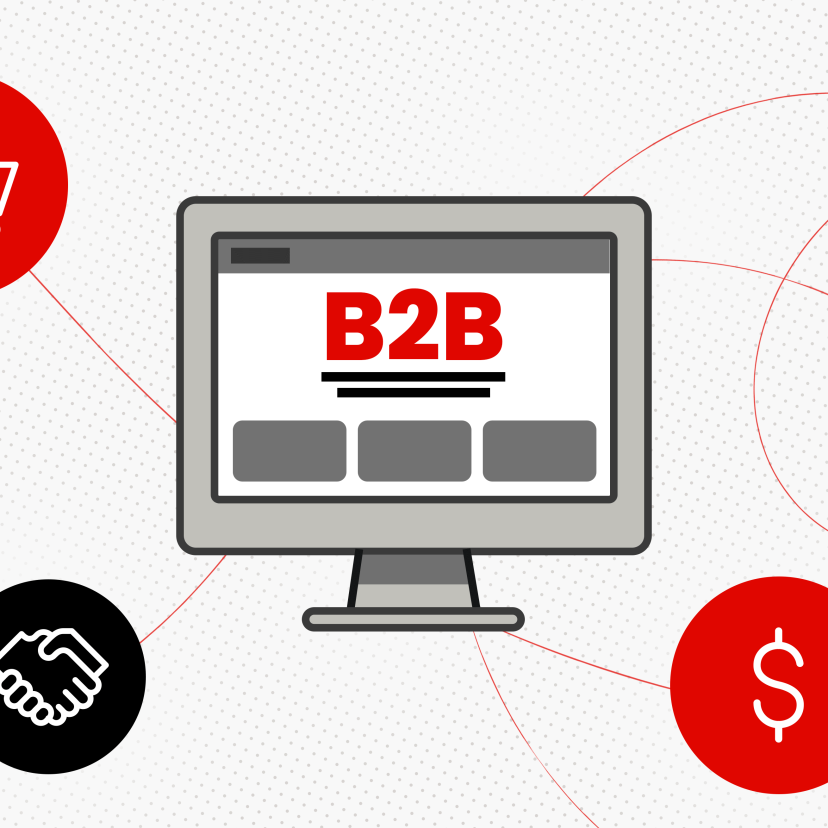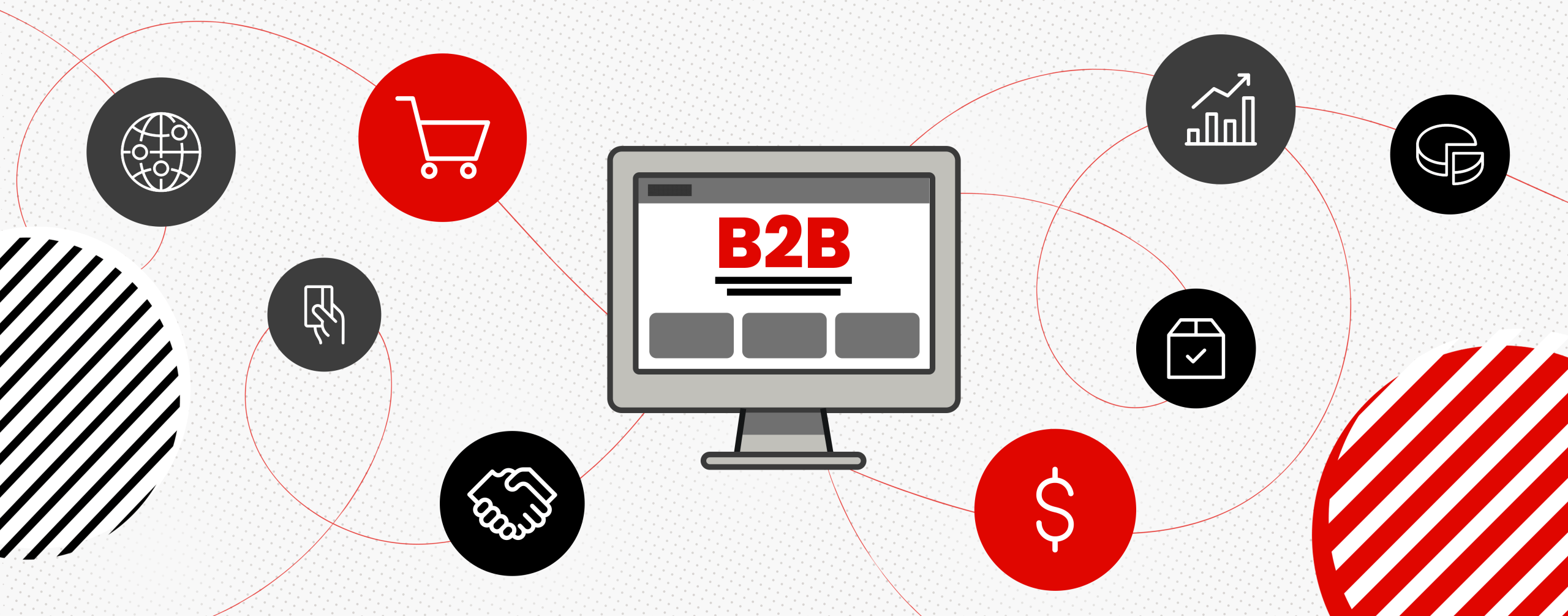
8 Best B2B Ecommerce Platforms for Your Business
Laura
Buzin

What works for B2C ecommerce rarely meets the needs of B2B operations. From complex pricing structures to negotiated terms and ERP integration, B2B ecommerce requires far more than a polished storefront — it demands a platform that can act as an operational backbone.
With dozens of options available, businesses must evaluate platforms through a different lens. Some specialize in open-source flexibility, others focus on industry-specific needs. But only a few are engineered to integrate seamlessly with the systems B2B organizations already depend on.
Ultimately, the platform you choose defines the buying experience your customers can expect, the efficiency your teams can maintain, and how your business scales over time.
So how do you cut through the noise and find the right fit? Let’s explore what to look for, how leading platforms compare, and why k‑ecommerce stands out as the most complete, ERP-connected solution for modern B2B growth.
How B2B Ecommerce Differs from B2C
A B2C customer ordering a single product online experiences a simple, standardized process. A B2B buyer ordering thousands of custom items across multiple locations faces a much different reality: volume-based pricing, negotiated contracts, approval workflows, and delivery coordination.
That is why B2B ecommerce platforms must handle:
- Complex pricing: Tiered rates, contract pricing, volume discounts, and credit terms.
- Customer relationships: Account hierarchies, user permissions, and dedicated portals.
- Order workflows: Quotes, purchase orders, approvals, and reordering.
- Integration: Real-time connectivity with ERP, CRM, and logistics systems.
- Self-service B2B portals: Buyer tools for reorders, invoices, and shipment tracking.
- Payment flexibility: Beyond credit cards — support for POs, account credit, and wire transfers.
Traditional B2C platforms simply don’t have the underlying architecture to manage these requirements. Choosing a purpose-built B2B ecommerce platform ensures the operational precision and scalability your customers expect.
Understanding Your B2B Ecommerce Needs
Before reviewing specific platforms, clarify what’s essential versus optional for your business. A well-chosen B2B ecommerce solution should not only meet current requirements but also scale alongside your growth.
These are the key areas to evaluate — each one critical to long-term success:
Scalability and Performance
B2B buyers expect the same level of reliability they experience on major consumer sites. Select a platform capable of handling increased traffic, larger product catalogs, and heavier order volumes without compromising speed or uptime.
Integration Capabilities
Integration isn’t an afterthought — it’s the foundation of sustainable B2B ecommerce. That’s why k‑ecommerce was designed to solve this challenge directly. With native integration to leading ERP systems, including Microsoft Dynamics and Acumatica, it eliminates the need for custom connectors or middleware. Real-time synchronization ensures pricing, inventory, and customer data remain accurate across every system and touchpoint.
This deep ERP connectivity reduces manual entry, data discrepancies, and operational friction — accelerating order processing while maintaining a single source of truth across the business.
Customization and Flexibility
Every business operates differently behind the scenes. While open-source platforms offer flexibility through development, that flexibility often comes at the cost of complexity and maintenance.
Solutions like k‑ecommerce strike a balance, allowing administrators to manage catalogs, pricing rules, and self-service features directly from the admin interface — no custom coding required. This adaptability supports growth without inflating development budgets or dependency on IT resources.
User Experience for Buyers and Administrators
User experience affects both sales and efficiency. For buyers, that means intuitive product discovery, quick reordering, and transparent order tracking. For administrators, it means streamlined workflows for managing products, customers, and orders.
For example, k‑ecommerce is built for both audiences — combining a modern, responsive storefront with a unified back-end interface that minimizes onboarding time and simplifies daily operations.
Security and Compliance
Data protection is non-negotiable in B2B commerce. Choose a platform that lets you incorporate enterprise-grade encryption, high availability, and global compliance with standards like GDPR and CCPA. The right pick ensures business continuity, data integrity, and trust at every stage of the buying journey.
Pricing Models and Total Cost of Ownership (TCO)
When evaluating cost, look beyond subscription fees. Implementation, maintenance, and integration can quickly inflate total ownership costs. Platforms that require custom middleware or complex setup can become expensive to sustain.
By contrast, platforms like k‑ecommerce reduce these overheads through a built-in ERP integration — accelerating deployment and minimizing long-term maintenance.
Top B2B Ecommerce Platforms
With your brand’s particular needs in mind, let’s examine the top ecommerce options in the B2B space.
Platform
Best For
Standout Features
k-ecommerce
Companies with Microsoft Dynamics or Acumatica seeking ERP-first ecommerce
Native, real-time ERP integration with zero middleware
Sana Commerce
Manufacturers, wholesalers, and distributors using Microsoft Dynamics or SAP
Deep ERP extension with self-service portal
OroCommerce
Enterprises needing extensive customization and multi-channel capabilities
Open-source flexibility with built-in CRM
TrueCommerce
Businesses requiring unified EDI and ecommerce management
Comprehensive commerce suite with strong EDI focus
Unilog
Distributors and wholesalers with complex product catalogs
Content-rich PIM with advanced search capabilities
NopCommerce
Companies seeking a cost-effective open-source solution
Flexible ASP.NET core platform with a strong community
Pepperi
Organizations with field sales teams and DSD operations
All-in-one B2B sales automation with offline capabilities
CS-Cart
Hybrid businesses selling to both B2B and B2C customers
Dual business model support from a single platform
1. k-ecommerce
k-ecommerce is purpose-built for B2B companies running leading ERP systems, including Microsoft Dynamics (365 Business Central, GP, NAV, and AX) and Acumatica, offering native, real-time integration that eliminates data silos and manual processes.
Unlike solutions that rely on connectors or middleware, k-ecommerce provides native ERP integration, enabling real-time synchronization of pricing, inventory, and customer data.
Pros:
- Native ERP integration: Real-time two-way data synchronization between ERP and ecommerce for orders, inventory, pricing, and customer accounts.
- Unified data management: Eliminates duplicate data entry and manual reconciliation, maintaining a single source of truth across systems.
- Reduced total cost of ownership: Fewer custom integrations and maintenance requirements compared to platforms like OroCommerce or NopCommerce and CS-Cart (depending on the configuration) that depend on middleware.
- B2B-focused design: Supports customer-specific pricing, account hierarchies, quotes, and repeat ordering workflows.
- Enterprise-level security: Hosted in a secure environment with built-in redundancy, encryption, and compliance with global data protection standards, including GDPR, SOC 2, and ISO 27001.
- Scalability and performance: Optimized for high-volume B2B transactions with a cloud-based infrastructure designed to grow alongside your business.
- Lower TCO: Native ERP integration means lower implementation costs, reduced ongoing maintenance, and minimal custom development compared to platforms requiring complex middleware or custom connectors.
Cons:
- Requires a compatible ERP: You need to connect it with one of the supported ERP systems to leverage k-ecommerce’s full capabilities.
2. Sana Commerce
Sana Commerce positions itself as an “ERP-integrated ecommerce” solution, emphasizing its deep, real-time connection with Microsoft Dynamics and SAP. It’s designed to make complex B2B sales seamless by leveraging the data already present in your ERP.
Pros:
- Native ERP integration: This is Sana’s superpower. It extends your ERP, providing real-time pricing, inventory, and customer data directly from your system of record. This eliminates data silos and the need for manual synchronization.
- Self-service customer portal: Robust features allow buyers to manage their accounts, reorder, view invoices, and track orders directly from the web store, reducing the burden on your customer service team.
- Complex pricing and logic: Handles intricate pricing rules, contract pricing, volume discounts, and customer-specific catalogs with ease.
Cons:
- Limited standalone use: Its strength is its ERP integration; it’s less suitable for businesses without a robust ERP or those looking for a standalone solution.
- Learning curve: It’s powerful, but comes with complex setup and administration.
3. OroCommerce
OroCommerce is an open-source, flexible B2B ecommerce platform built on the Symfony framework — a mature PHP framework known for enterprise-grade applications, offering robust architecture and extensive component libraries for building scalable web solutions. It’s best for businesses with complex requirements and a need for extensive customization.
Pros:
- Highly customizable: As an open-source platform, it offers unparalleled flexibility to tailor every aspect to specific business needs. For instance, you can create custom workflows, unique checkout processes, personalized account management interfaces, and bespoke pricing engines.
- Multi-channel and multi-brand: Supports multiple websites, brands, and customer types from a single instance, ideal for diverse business models.
- CRM capabilities: Built-in CRM functionalities offer opportunities to personalize experiences and better track interactions.
- Robust B2B features: Comprehensive support for complex pricing, corporate accounts, approval workflows, and quick order forms.
Cons:
- Requires technical expertise: Its open-source nature and high customizability mean you’ll need access to strong technical resources for implementation and ongoing management.
- Higher TCO: Extensive customization and maintenance can lead to a higher overall TCO.
- Steeper learning curve: The number of admin interface features and options — from configuring multi-level account hierarchies to setting up complex product attributes and managing workflow automations — can be daunting for new users.
4. TrueCommerce
TrueCommerce offers a unified commerce platform emphasizing B2B ecommerce alongside EDI (Electronic Data Interchange) — a standardized electronic format for exchanging business documents like purchase orders and invoices between trading partners — PIM (Product Information Management), and integration solutions.
Pros:
- Strong EDI and integration focus: Excellent for businesses relying heavily on EDI for supplier and customer interactions, providing unified ecommerce and EDI management.
- Comprehensive commerce suite: The broader ecosystem includes PIM, fulfillment, and dropshipping — offering end-to-end solutions for complex supply chains.
- Scalable infrastructure: Designed to handle growing order volumes and expanding product catalogs.
Cons:
- Platform complexity: The comprehensive suite can overwhelm smaller businesses or those with simpler requirements.
- Significant learning curve: Integrating and managing various platform components requires substantial training investment.
- Enterprise pricing: Depending on how comprehensive your needs are, you should expect costs to scale quickly.
5. Unilog
Unilog provides B2B ecommerce solutions specifically for distributors and wholesalers, focusing on rich product content, advanced search capabilities, and personalized buying experiences.
Pros:
- Content-rich product pages: Excellent PIM capabilities handle complex product attributes, technical specifications, and rich media effectively.
- Advanced search and navigation: A powerful search engine and robust faceted navigation help buyers quickly find products in large catalogs.
- Personalized buyer experiences: Delivers customer-specific pricing, product catalogs, and promotional content.
Cons:
- Extended implementation timeline: More involved setup due to its focus on content management and complex product data. For example, it requires detailed product attribute mapping, taxonomy development, content enrichment workflows, and extensive data migration from legacy systems that other platforms may handle more simply.
- Content management learning curve: The content system requires significant time to master because it offers granular control over product information architecture, multi-level categorization, and complex attribute relationships that demand both strategic planning and technical understanding.
- Higher investment: The comprehensive PIM capabilities, content enrichment services, and complex implementation can drive total costs significantly higher — particularly for businesses with large product catalogs requiring extensive content management.
6. nopCommerce
nopCommerce is a popular open-source ecommerce platform based on ASP.NET Core, offering robust features for both B2C and B2B businesses with a strong developer community.
Pros:
- Flexible and extendable: Open-source foundation enables high customization levels and extension through plugins and custom development.
- Comprehensive features: Out-of-the-box support for multi-store, multi-vendor, and essential B2B functionalities, including tiered pricing, customer roles, and purchase orders.
- Cost-effective licensing: The platform itself is technically free, though hosting, development, and support costs apply.
Cons:
- Requires technical expertise: Implementing and maintaining nopCommerce, especially with heavy customization, requires specialized development skills.
- Complex scalability: While scalable, ensuring high performance for large B2B operations may require significant optimization and infrastructure investment.
- Self-managed hosting: You’re responsible for hosting, security updates, and maintenance — unlike managed SaaS platforms.
7. Pepperi
Pepperi offers an all-in-one B2B sales automation platform combining B2B ecommerce, Salesforce automation (SFA), and route accounting, optimized for field sales teams.
Pros:
- B2B ecommerce portal: Self-service customer portal complements field sales with online ordering, account management, and payment processing.
- Route accounting and merchandising: Supports direct store delivery (DSD) and merchandising activities effectively.
- Offline capabilities: Sales reps can work offline and sync data when connectivity is restored.
Cons:
- Field sales focus: While it includes a B2B portal, the primary strength lies in supporting field sales teams. Businesses with purely online sales models might find other platforms more focused on their needs.
- Platform complexity: Its comprehensive feature set can be complex to implement and manage effectively.
- Enterprise pricing: Full-suite solution typically requires a higher investment.
8. CS-Cart
CS-Cart offers CS-Cart Multi-Vendor (for marketplaces) and CS-Cart B2B and B2C — an all-in-one solution designed to serve both business models from a single platform.
Pros:
- Hybrid B2B and B2C capability: One platform manages both business models — ideal for companies selling to consumers and businesses.
- Feature-rich: Includes robust B2B features like customer-specific pricing, hidden prices for logged-in users, minimum order quantities, and quick order forms.
- Self-hosted and flexible: Software ownership allows extensive customization and control over the hosting environment.
- Cost-effective licensing: One-time license fee with optional upgrade subscriptions.
Cons:
- Technical resources required: Self-hosted platform setup, customization, and maintenance require significant technical expertise.
- Scalability demands optimization: Large enterprises need optimization and robust hosting for peak performance.
Choose the Right B2B Ecommerce Platform for Your Business
Making the right platform decision requires evaluating your:
- Current technology stack and available integrations — particularly your ERP system
- Budget and total cost of ownership over at least three years — the typical timeframe before major platform upgrades or migrations become necessary as your business scales and requirements evolve
- Internal technical expertise and resources
- Growth projections and scalability requirements
- Industry-specific compliance and security needs
And remember: The right platform doesn’t just process transactions — it enhances customer experience, streamlines operations, and scales with your growth. Choose a solution built for your specific technology environment and business model.
For businesses running Microsoft Dynamics or Acumatica, platform selection becomes clearer: k-ecommerce specializes in seamless, native integration with these leading ERP systems. This eliminates the integration complexity, data synchronization issues, and custom development costs that plague businesses trying to connect generalized platforms to their ERP.
Schedule a demo to see how native ERP integration can transform your B2B ecommerce operations.


